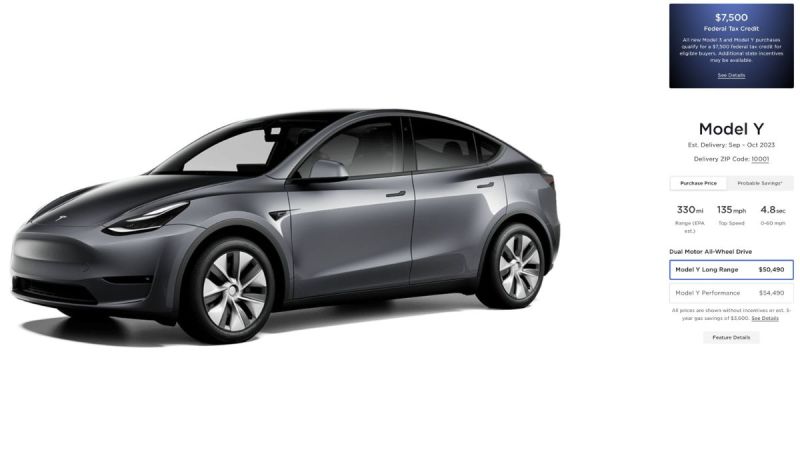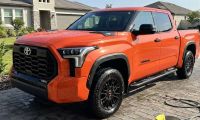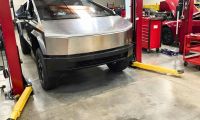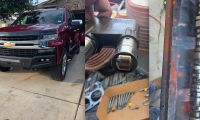In a surprising move, Tesla has made significant changes to its Model Y lineup in the United States, a development that could have far-reaching consequences for the availability of 4680 cells and the production of the highly anticipated Cybertruck. This news was brought to light by Tesla blogger Sawyer Merritt, who noticed the sudden removal of the Model Y AWD variant from Tesla's official US website.
As a result of this change, the base price for the Model Y in the US now starts at $50,490, excluding incentives.
BREAKING: Tesla has removed the Model Y AWD variant from their US website. This means the Model Y now starts at $50,490 in the US (before incentives).
Tesla might be wanting to allocate this 4680 cells production capacity for the Cybertruck. pic.twitter.com/9p24gnlvAt— Sawyer Merritt (@SawyerMerritt) September 15, 2023
Why This Matters
The removal of the Model Y AWD variant from Tesla's lineup is not a minor adjustment but rather a strategic move that could have several important implications for Tesla and its product offerings. Let's break down the key aspects of this development and their potential consequences:
1. Implications for 4680 Cells: One of the most significant speculations stemming from this change is that Tesla may be reallocating the production capacity of its cutting-edge 4680 battery cells to prioritize the Cybertruck. This shift in focus suggests that Tesla is making strategic decisions to ensure the timely launch and production of its all-electric pickup truck.
Sawyer Merritt raises a pertinent question: Is Cybertruck already siphoning sales from the Model Y in the US? While this question is posed as an opinion, it's important to note that it's grounded in the observation that Tesla has effectively reduced the Model Y lineup in the US to just two variants—the Long Range (LR) and Performance models. By discontinuing the Model Y AWD (Standard Range) variant, Tesla has limited consumer choices and potentially impacted sales.
The consequences of this decision could be significant. Tesla could potentially sell tens of thousands fewer Model Ys this year than it might have if the popular Model Y AWD variant had remained available for purchase. This raises concerns about the impact on Tesla's overall sales and market positioning in the US.
2. Battery Supply Shortage: If the removal of the Model Y AWD variant is indeed related to a shortage of batteries, it underscores a broader concern about battery supply constraints. Tesla relies on its 4680 cells for various vehicle models, including the Cybertruck. A shortage of these advanced battery cells could pose challenges for Tesla's production goals and timelines.
The suggestion that Tesla is canceling production of Model Ys to conserve batteries for the Cybertruck points to a potential one-for-one exchange. However, it's important to note that the production of a Cybertruck requires more batteries than that of a Model Y, amplifying the impact of this decision. This could result in a situation where Tesla ends up producing fewer Model Ys while striving to ramp up Cybertruck production.
3. Impact on Tesla Stationary Storage (Megapack): Another aspect to consider is how this decision might affect Tesla's stationary storage solutions, particularly the Megapack. Megapacks use batteries with lower energy density, which are often the least expensive options available to Tesla. The weight of these batteries is not a concern for stationary installations. As a result, Megapacks could continue to use any leftover batteries from production.
While the production of Model Ys may be curtailed due to battery supply constraints, it's unlikely to have a significant impact on Megapack supplies or the overall number of Model 3 and Model Y vehicles that Tesla can deliver. Megapacks are optimized to utilize batteries that might not meet the specifications required for electric vehicles, ensuring minimal waste of resources.
Tesla's decision to remove the Model Y AWD variant from its US lineup raises important questions about its strategic priorities, battery supply, and the potential impact on Model Y sales and the Cybertruck production timeline. While it's too early to definitively assess the long-term consequences, it's clear that Tesla is making calculated moves to address its battery supply challenges and meet the growing demand for electric vehicles.
The situation highlights the delicate balance that Tesla must strike as it navigates the evolving landscape of electric vehicle production and ensures that it remains at the forefront of the industry. The coming months will likely provide more insights into how these changes will shape Tesla's future and its ability to meet the increasing demand for sustainable transportation.
Do you think Tesla is removing this variant of the Model Y from its US website in order to allocate the 4680 battery cells to
Armen Hareyan is the founder and the Editor in Chief of Torque News. He founded TorqueNews.com in 2010, which since then has been publishing expert news and analysis about the automotive industry. He can be reached at Torque News Twitter, Facebok, Linkedin and Youtube. He has more than a decade-long expertise in the automotive industry with special interest in Tesla and electric vehicles.
Source: According to Tesla blogger Sawyer Merritt and Twitter suggestions.











